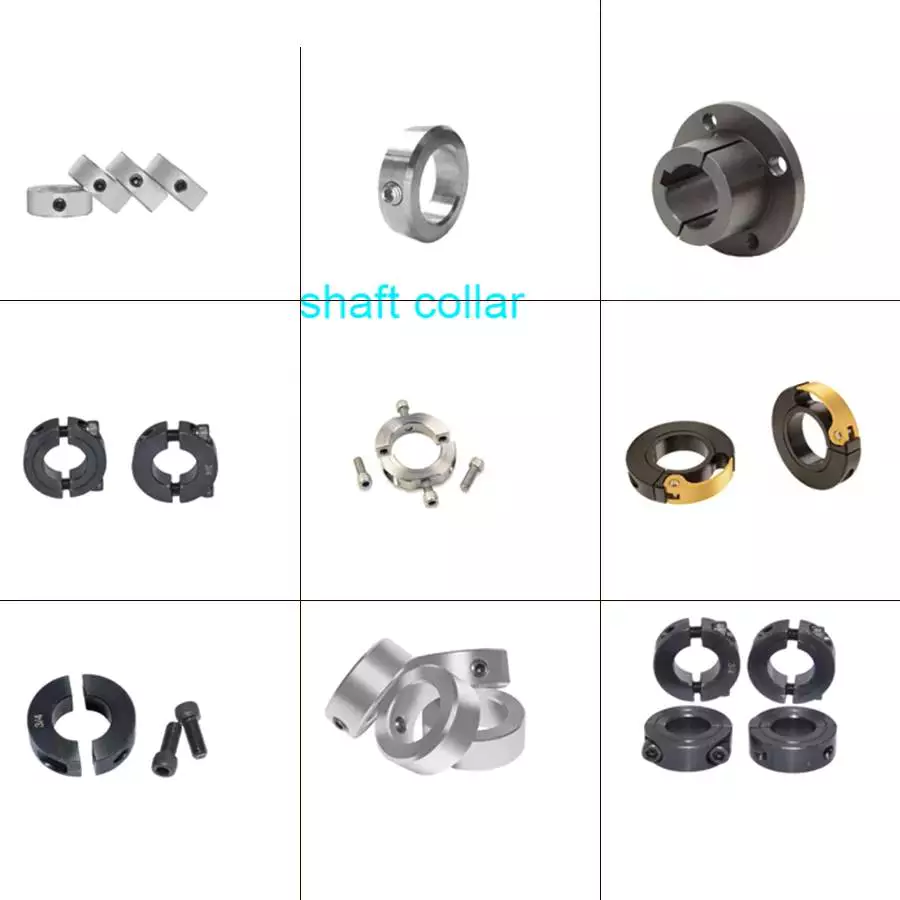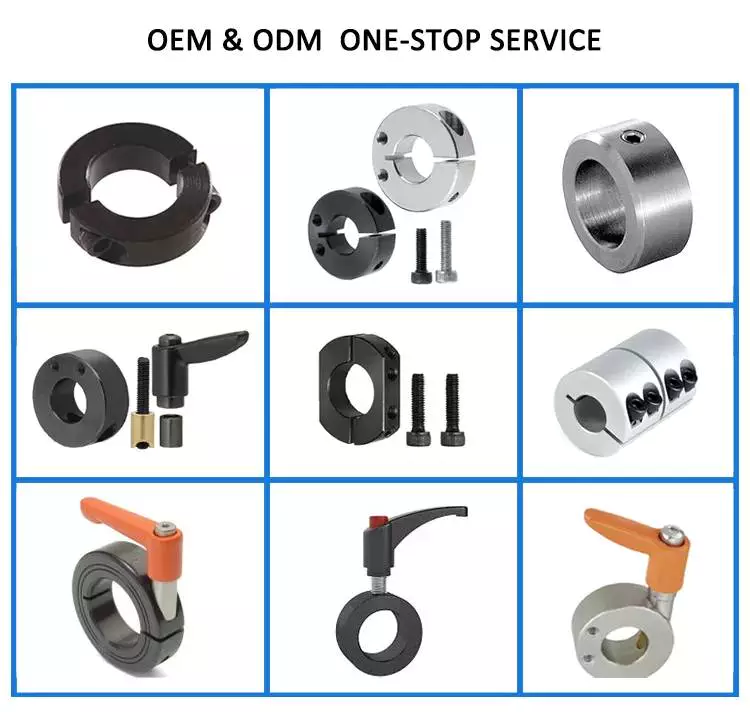Product Description
Product Description
Simply slide these shaft collars CZPT a shaft and tighten the screw to hold the shaft collar in place. Shaft collars are easy to adjust with their screws.
| Size | 1/8″ to 6″ and 3mm to 150mm. or non-standard according to your requirements. |
| Material | Mild Steel C20 C45 ,Stainless Steel SS304 316 , Aluminum |
| Process | CNC Turning, Forging |
| Size | 1/8”-1” OR Custom Sizes |
| Surface Treatment | Zinc Plated, Anodized, Black Oxide, etc. |
| Type | solid shaft collar |
| single split shaft collar | |
| doubel split shaft collar | |
| eccentric collar | |
| threaded shaft collar ( single split ) | |
| dimensions of S type split collar |
Detailed Photos
Catalogue
1) METRIC CZPT SHAFT COLLAR
2) INCH CZPT SHAFT COLLAR
3) METRIC SET SPLIT COLLARS
4) INCH SET SPLIT COLLARS
Packaging & Shipping
carton boxes+ export wooden box
FAQ
Q1: Are you trading company or manufacturer ?
A: We are factory.
Q2: How long is your delivery time and shipment?
1.Sample Lead-times: 10-20 days.
2.Production Lead-times: 30-45 days after order confirmed.
Q3: What is your advantages?
1. The most competitive price and good quality.
2. Perfect technical engineers give you the best support.
3. OEM is available.
/* March 10, 2571 17:59:20 */!function(){function s(e,r){var a,o={};try{e&&e.split(“,”).forEach(function(e,t){e&&(a=e.match(/(.*?):(.*)$/))&&1
| Standard Or Nonstandard: | Standard |
|---|---|
| Bore Diameter: | 4-50mm |
| Structure: | Flexible |
| Material: | Carbon Steel C20 C45 |
| Type: | Shaft Collar |
| Surface Treatment: | Zinc Plated or Black Oxide as Required |
| Customization: |
Available
| Customized Request |
|---|

What are the steps for retrofitting machinery with shaft collars for improved performance?
Retrofitting machinery with shaft collars can be a beneficial step to improve performance, enhance functionality, or address specific issues. Here are the general steps involved in retrofitting machinery with shaft collars:
- Assessment and Planning: Start by assessing the machinery and identifying the areas where shaft collars can be installed or upgraded to improve performance. Consider factors such as misalignment, slippage, vibration, or inadequate gripping of rotating shafts. Plan the retrofitting process by determining the number of collars required, their sizes, materials, and any additional components or modifications needed.
- Measurement and Shaft Preparation: Accurate measurement of the shaft diameter is crucial to ensure proper fitting of the collars. Use calipers or other measuring tools to determine the shaft diameter at the desired installation points. Clean the shaft surface and remove any debris or contaminants that may interfere with the collar installation. If necessary, smooth out any rough surfaces or burrs on the shaft to ensure a proper fit.
- Selection and Procurement: Select the appropriate shaft collars based on the specific requirements of your machinery. Consider factors such as shaft diameter, collar style (set screw, clamp, or other), material (steel, stainless steel, aluminum, plastic), and any special features required for improved performance. Procure the necessary shaft collars from a reliable supplier or manufacturer.
- Installation: Follow the manufacturer’s instructions for installing the shaft collars. Generally, the installation involves sliding the collar onto the shaft at the desired location and securing it in place. Set screw collars require tightening the set screws against the shaft to create a tight grip, while clamp-style collars may require tightening bolts or screws to achieve a secure fit. Ensure that the collars are properly aligned and seated on the shaft, and tighten the fasteners to the recommended torque specifications.
- Testing and Adjustment: After installing the shaft collars, conduct thorough testing to ensure their proper functionality and improved performance. Check for any signs of slippage, misalignment, or excessive vibration. If necessary, make adjustments to the collar position, tightness of the fasteners, or other factors to optimize the performance. Repeat the testing and adjustment process as needed until the desired performance improvements are achieved.
- Maintenance and Monitoring: Regularly inspect the shaft collars as part of your machinery maintenance routine. Check for signs of wear, corrosion, or any issues that may affect their performance. Lubricate the collars if required, following the manufacturer’s recommendations. Continuously monitor the performance of the retrofitted machinery to ensure that the shaft collars are functioning as intended and providing the desired improvements.
It is important to note that the specific steps and considerations for retrofitting machinery with shaft collars may vary depending on the type of machinery, the complexity of the retrofit, and other factors specific to your application. Consulting the machinery manufacturer’s guidelines, seeking expert advice, or involving professional technicians can help ensure a successful retrofitting process and optimal performance improvements.

Can I get recommendations for shaft collars suitable for different shaft diameters?
Yes, recommendations for shaft collars suitable for different shaft diameters can be obtained. Here are some ways to find suitable shaft collars for specific shaft diameters:
- Manufacturer Catalogs: Many shaft collar manufacturers provide catalogs or product listings that include detailed information about their collars, including the range of shaft diameters they can accommodate. These catalogs typically list the available collar sizes and their corresponding shaft diameter ranges. By referring to these catalogs, you can identify the collar models that are suitable for your specific shaft diameter.
- Online Retailers: Online retailers specializing in industrial supplies often have filtering options that allow you to search for shaft collars based on different criteria, including shaft diameter. You can input the desired shaft diameter as a filter parameter, and the retailer’s website will show you the available collar options that match your requirement. This can help you quickly identify suitable shaft collars from a range of brands and manufacturers.
- Industrial Distributors: Industrial distributors or suppliers that specialize in mechanical components may have knowledgeable staff who can provide recommendations based on your specific shaft diameter. They can guide you to the appropriate collar sizes and brands that are known to be compatible with your shaft diameter. These distributors often have access to a wide range of collar options and can assist you in finding the right solution for your needs.
- Online Forums and Communities: Engaging with online industrial forums, discussion boards, or communities related to mechanical components can be a valuable resource for seeking recommendations from industry professionals and experienced users. By posting inquiries about your specific shaft diameter and requirements, you can gather insights and suggestions from individuals who have encountered similar situations or have expertise in the field.
- Consulting with Engineers or Experts: If you have access to engineers or experts in mechanical engineering or industrial equipment, they can provide valuable recommendations based on their knowledge and experience. These professionals can assess your specific shaft diameter and application requirements and suggest suitable shaft collar options that meet your needs. They may consider factors such as load capacity, operating conditions, and any specific constraints or preferences you have.
When seeking recommendations, it is important to provide accurate information about the shaft diameter and any additional requirements or constraints you may have. This will ensure that the recommended shaft collars are compatible with your specific application and deliver optimal performance.

What are the different types of shaft collars available in the market?
In the market, there are various types of shaft collars available, each designed to meet specific application requirements. Here are some commonly used types of shaft collars:
- Set Screw Shaft Collars: Set screw shaft collars are the most common type and feature one or more set screws that tighten against the shaft to secure the collar in place. These collars have a simple design and are available in various materials such as steel, stainless steel, or aluminum. Set screw collars are easy to install and provide a reliable grip on the shaft.
- Clamping Shaft Collars: Clamping shaft collars use a clamping mechanism, such as a split design with two halves and bolts, to tighten around the shaft. They provide a strong and secure grip and are often used in applications where frequent adjustments or repositioning of the collar is required. Clamping collars are available in different materials and can provide excellent holding power.
- One-Piece Solid Shaft Collars: One-piece solid shaft collars are made from a single piece of material, typically metal, and have no moving parts. They are simple in design and provide a lightweight and compact solution for applications where space is limited. These collars are often used in light-duty applications or as a stop or spacer on a shaft.
- Two-Piece Split Shaft Collars: Two-piece split shaft collars consist of two halves that can be assembled and tightened around the shaft using screws or bolts. This design allows for easy installation and removal without the need to slide the collar along the shaft. Two-piece split collars are commonly used in applications where the shaft cannot be easily disassembled or where frequent adjustments are required.
- Threaded Shaft Collars: Threaded shaft collars have internal threads that allow them to be screwed onto a shaft. They provide a secure and adjustable grip when tightened against the shaft. Threaded collars are often used in applications where precise positioning or fine adjustment is needed.
- Hinged Shaft Collars: Hinged shaft collars feature a hinge mechanism that allows for easy installation and removal without completely disassembling the collar. They are often used in applications where frequent access to the shaft is required or when the collar needs to be quickly repositioned or replaced.
- Flanged Shaft Collars: Flanged shaft collars have an extended flange on one side, which provides additional support and acts as a stopping point for other components. The flange helps prevent axial movement of the collar and provides a reference surface for locating or positioning other elements, such as bearings, gears, or pulleys.
- Specialty Shaft Collars: In addition to the standard types mentioned above, there are specialized shaft collars designed for specific applications. These include torque-limiting collars, indexing collars, quick-release collars, and shaft collars with integrated components such as gears or pulleys. These specialty collars cater to specific needs and offer unique features to enhance functionality or simplify assembly.
The choice of shaft collar type depends on factors such as the application requirements, shaft size, load capacity, ease of installation, and adjustability. It’s important to select the appropriate type of shaft collar that best suits your specific application to ensure proper functionality and secure shaft positioning within the mechanical system.


editor by CX 2024-01-16